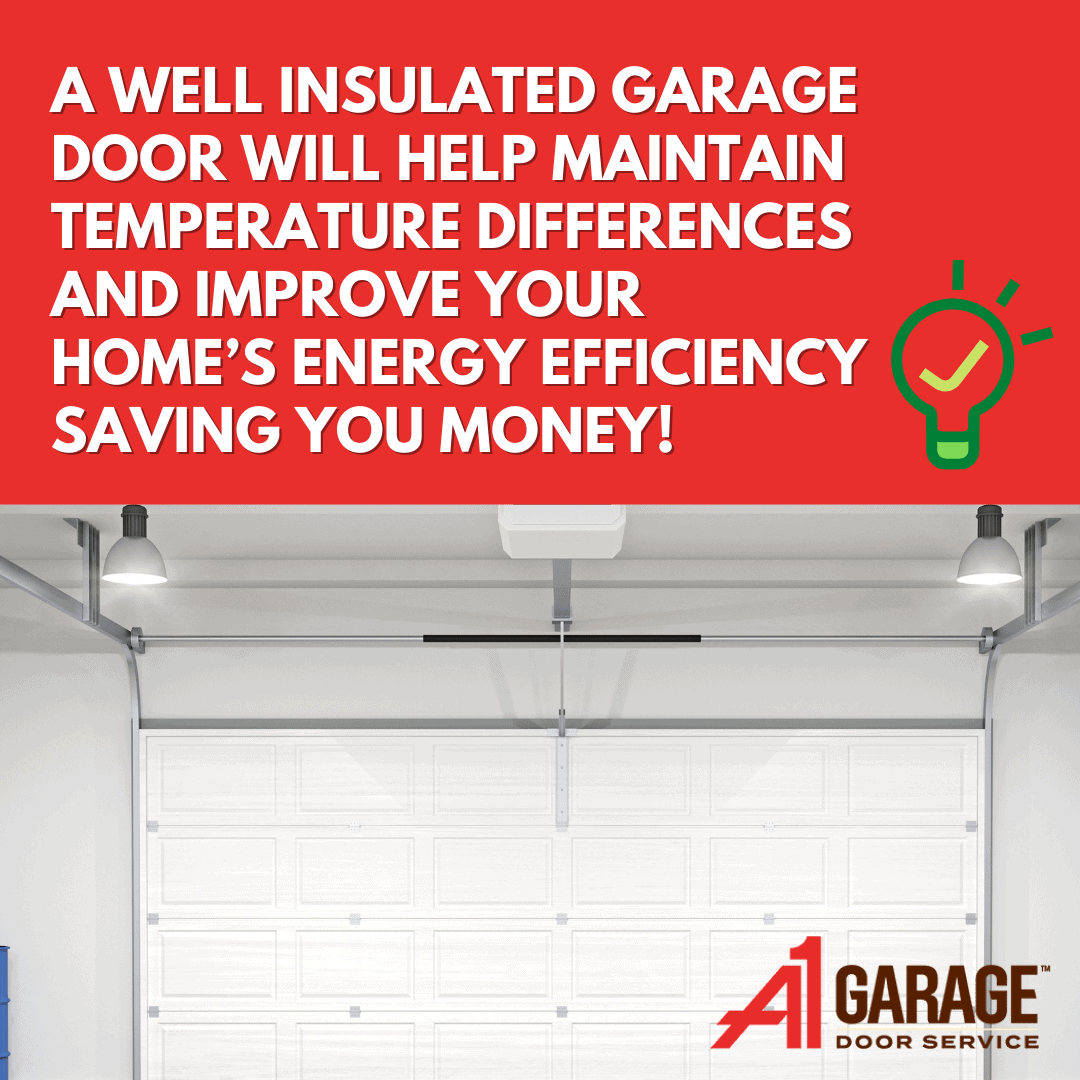Welcome to the world of energy-efficient solutions! Ever wondered how to insulate a garage door for improved energy efficiency? Well, you’re in the right place. Whether you’re trying to keep the cold air out during winter or the heat at bay during the scorching summer months, we’ve got you covered with some easy and effective tips. So, let’s dive in and explore the world of garage door insulation!
Picture this: a garage that stays cozy in winter and cool in summer. Sounds like a dream, right? Well, insulating your garage door can make that dream a reality. Whether you use your garage as a workshop, game room, or simply for parking your car, insulating the door can help save energy and make your space more comfortable. And don’t worry, it’s not as complicated as it may seem! With a few simple steps, you’ll be on your way to a better-insulated garage.
Before we jump into the ins and outs of garage door insulation, let’s talk about why it’s important. An uninsulated garage door can be a major source of heat loss or gain in your home. This means your heating and cooling systems have to work harder to maintain a comfortable temperature, leading to higher energy bills. By insulating your garage door, you can create a barrier that prevents air leakage and regulates the temperature in your garage. Ready to learn how? Let’s get started!
Does your garage feel like an icebox in the winter or an oven in the summer? Insulating your garage door can help regulate temperatures and save on energy costs. Here’s a step-by-step guide to insulating your garage door for improved energy efficiency:
- Clean the door surface
- Measure and cut the insulation material
- Attach the insulation panels
- Seal gaps and cracks with weatherstripping
- Install a garage door threshold seal
Make your garage more comfortable year-round with these insulation tips.

How to Insulate a Garage Door for Improved Energy Efficiency
In today’s world where energy conservation and cost-efficiency are of utmost importance, it’s crucial to take steps to insulate your home properly. One area that often gets overlooked is the garage door. Many homeowners fail to recognize the impact that an uninsulated garage door can have on their energy bills. Insulating your garage door not only helps to maintain a comfortable temperature within the garage but also greatly improves the overall energy efficiency of your home. In this article, we will provide you with a comprehensive guide on how to insulate a garage door for improved energy efficiency, helping you save money and reduce your carbon footprint.
Why Should You Insulate Your Garage Door?
Insulating your garage door offers a multitude of benefits, making it a worthwhile investment. Here are the key reasons why you should consider insulating your garage door:
1. Energy Efficiency: An insulated garage door provides an additional layer of insulation for your home, reducing the transfer of heat or cold between the garage and the living spaces. This helps to stabilize the indoor temperature, reducing the load on your heating and cooling systems and ultimately lowering energy consumption.
2. Enhanced Comfort: Insulation acts as a barrier against extreme temperatures, preventing the garage from becoming too hot or too cold. With proper insulation, you can maintain a more comfortable environment in your garage, making it more pleasant for any activities or projects you undertake there.
3. Noise Reduction: Insulation helps to dampen noise, making your garage quieter. This is especially beneficial if you have a living area adjacent to or above the garage. Insulating your garage door can help to reduce noise transfer, allowing you to enjoy a quieter and more peaceful home environment.
Types of Garage Door Insulation
When it comes to insulating your garage door, there are a few different insulation options to choose from. Each type has its own unique characteristics and benefits. Let’s take a look at the most common types of garage door insulation:
1. Batt Insulation:
Batt insulation is one of the most common and affordable options for garage door insulation. It consists of fiberglass or mineral wool panels that come in standard sizes to fit within the frames of most garage doors. Batt insulation offers good thermal performance and is relatively easy to install, making it a popular choice for DIY enthusiasts.
When installing batt insulation, it’s important to ensure a snug fit and cover the entire surface of the door evenly to achieve maximum insulation efficiency. Additionally, a vapor barrier should be installed to prevent condensation and moisture buildup.
2. Reflective Foil Insulation:
Reflective foil insulation, also known as radiant barrier insulation, is a popular choice for garage door insulation due to its effectiveness in reflecting radiant heat. It consists of a layer of foil sandwiched between a layer of foam or other insulating material. The foil reflects heat away from the garage door, minimizing heat transfer.
Reflective foil insulation is lightweight and easy to install. It typically comes in rolls and can be cut to fit your garage door’s dimensions. This type of insulation is particularly suitable for regions with hot climates and can significantly reduce heat gain in your garage.
3. Polystyrene Insulation:
Polystyrene insulation is a rigid foam board insulation that offers excellent thermal resistance. It is durable, lightweight, and moisture-resistant, making it a good choice for garage door insulation.
Polystyrene insulation is available in different thicknesses, allowing you to choose the level of insulation you need for your garage door. It can be installed by cutting the panels to fit within the door frames and securing them in place using adhesive or brackets.
4. Polyurethane Foam Insulation:
Polyurethane foam insulation is a high-performance option that provides superior insulation properties. It is typically injected into the garage door panels, expanding and filling any gaps or voids, creating an airtight seal.
This type of insulation offers the highest R-value (a measure of thermal resistance) and can significantly improve the energy efficiency of your garage door. Polyurethane foam insulation also adds structural rigidity to the door, making it more durable and resistant to impacts.
DIY Garage Door Insulation Steps
Insulating your garage door is a project that can be tackled by most DIY enthusiasts. Follow these steps to effectively insulate your garage door:
1. Measure and Prepare:
Start by measuring your garage door panels to determine the amount of insulation material you will need. Clean the door surfaces thoroughly, ensuring they are free from dust and debris before starting the insulation process.
2. Choose the Insulation Material:
Select the type of insulation material that best suits your needs and budget. Consider factors such as thermal performance, ease of installation, and cost.
3. Cut and Install the Insulation Material:
Cut the insulation material to fit the dimensions of your garage door panels. Depending on the type of insulation, you may need to use an adhesive, brackets, or tape to secure the insulation in place.
Ensure a snug fit and cover the panels entirely. Pay attention to any joints or areas where the insulation meets to prevent air leakage or thermal bridging.
4. Seal the Edges:
Seal the edges of the insulation using foam sealant or weatherstripping to further enhance the insulation performance and prevent drafts.
5. Install a Garage Door Insulation Kit:
If you want a hassle-free insulation solution, you can opt for a garage door insulation kit. These kits come with pre-cut insulation panels and all the necessary hardware for installation. Follow the instructions provided with the kit to ensure proper installation.
6. Test and Monitor:
After insulating your garage door, monitor the indoor temperature, energy consumption, and comfort level in your garage. Make any necessary adjustments or repairs to achieve optimal energy efficiency and comfort.
Maintaining Insulated Garage Doors
To ensure the longevity and efficiency of your insulated garage door, it’s important to perform regular maintenance. Here are a few tips to help you maintain your insulated garage door:
1. Cleanliness:
Regularly clean your garage door, removing any dirt, dust, or debris that may accumulate on the surface. Use a mild detergent and a soft cloth or sponge to gently clean the door.
2. Inspect and Repair:
Inspect your garage door regularly for any signs of damage or wear. Check for cracks, dents, or gaps in the insulation and repair or replace as needed. Ensure weatherstripping and other sealing components are in good condition.
3. Lubrication:
Apply a silicone-based lubricant to the moving parts of your garage door, such as the tracks, rollers, and hinges. This helps to reduce friction and ensure smooth operation.
4. Weather Stripping Replacement:
Over time, weatherstripping can wear out or become damaged, compromising the insulation performance. Periodically inspect the weatherstripping and replace it if necessary to maintain optimal insulation efficiency.
Conclusion:
Insulating your garage door is a cost-effective and efficient way to improve the energy efficiency of your home. By following the steps outlined in this article, you can enhance comfort, reduce energy consumption, and save money on your utility bills. Whether you choose batt insulation, reflective foil insulation, polystyrene insulation, or polyurethane foam insulation, the key is to ensure proper installation and regular maintenance for optimal results. Take the necessary steps to insulate your garage door today and enjoy the benefits for years to come.
Key Takeaways: How to Insulate a Garage Door for Improved Energy Efficiency
How to Insulate a Garage Door for Improved Energy Efficiency
- Insulating your garage door can help save energy and lower utility bills.
- Start by measuring the dimensions of your garage door to determine the amount of insulation needed.
- Choose the right insulation materials, such as reflective foil, foam boards, or fiberglass batts.
- Install the insulation material according to the manufacturer’s instructions, ensuring a snug fit.
- Consider adding weatherstripping and a bottom seal to further improve energy efficiency.
Remember, proper insulation of your garage door can make a big difference in maintaining a comfortable temperature in your garage and reducing energy waste. Follow these steps to improve your garage’s energy efficiency and enjoy the benefits of lower energy bills.
Frequently Asked Questions
Welcome to our Frequently Asked Questions regarding insulating your garage door for improved energy efficiency! Below, we’ve answered some common queries to help you make your garage more comfortable and reduce energy waste.
Q: How does insulating a garage door improve energy efficiency?
A: Insulating your garage door helps improve energy efficiency by preventing outside air from seeping into your garage. This insulation acts as a barrier, reducing heat transfer and keeping the temperature inside your garage more stable. By minimizing air leaks, you can prevent heat loss in the winter and keep your garage cooler in the summer, resulting in energy savings.
Additionally, insulating your garage door can reduce noise transmission from the outdoors and provide better soundproofing, making your garage a quieter space.
Q: What materials can I use to insulate my garage door?
A: There are various materials you can use to insulate your garage door, including reflective insulation panels, polystyrene foam boards, and fiberglass batt insulation. Reflective insulation panels are easy to install and provide good thermal resistance. Polystyrene foam boards are lightweight, durable, and offer excellent insulation properties. Fiberglass batt insulation is another popular choice, providing effective thermal insulation and soundproofing. Choose the material that suits your budget, insulation needs, and personal preferences.
Remember, it’s important to measure your garage door accurately and ensure proper installation of the insulation materials to maximize their effectiveness.
Q: Can I insulate my existing garage door, or do I need to replace it?
A: In most cases, you can insulate your existing garage door without needing to replace it. Garage door insulation kits are available, which typically include insulation panels and installation materials. These kits are designed to fit various garage door sizes and can be installed on both single and double garage doors. However, if your garage door is old, damaged, or lacks proper structural integrity, it may be more beneficial to consider replacing it with an insulated door specifically designed for energy efficiency.
Consult a professional or follow the manufacturer’s instructions when installing insulation on your existing garage door.
Q: How do I install insulation on my garage door?
A: Insulating a garage door is a DIY-friendly project. Start by cleaning the door surface and ensuring it’s free from dust and debris. Measure the dimensions of your garage door panels and cut the insulation material accordingly. Attach the insulation panels to the garage door using adhesive or tape, following the manufacturer’s instructions. Secure the edges with aluminum tape to create a tight seal.
It’s important to pay attention to safety precautions, such as wearing gloves and eye protection, while handling insulation materials. If you’re unsure about the installation process, it’s always best to consult a professional.
Q: Will insulating my garage door affect its operation?
A: When properly installed, garage door insulation should not negatively affect the operation of your garage door. However, it’s important to ensure that the added weight of the insulation material doesn’t exceed the door’s weight capacity and strain the springs or opener. Insulation panels are lightweight, so they typically don’t pose a problem.
If you have any concerns about the impact of insulation on your garage door’s operation, consult the manufacturer’s guidelines or seek advice from a professional garage door technician. They can assess your specific door and provide guidance on insulation without compromising functionality.

Summary
Insulating your garage door can help you save energy and keep your home comfortable. By adding insulation materials like foam panels or reflective foil, you can reduce heat transfer and keep the cold air out. Make sure to measure your garage door accurately and choose the right type of insulation for your needs. Additionally, sealing any gaps or cracks in the door using weatherstripping or caulk can further improve energy efficiency. Lastly, maintaining your garage door by keeping it clean and well-maintained will help ensure its effectiveness in insulating your space.
Overall, insulating your garage door is a simple and effective way to save energy, reduce heating and cooling costs, and make your home more comfortable. With a few easy steps, you can make a big difference in your energy efficiency and keep your garage and home cozy all year round.

